The sheer scale of this one of many AI factories of the near future tell us a lot about AI direction, and adds meat to the bones of Jensens speech in Taipei this week.
Enjoy.
~~~~~~~~~~~~~~~~~~~~~~
OpenAI, Oracle and SoftBank hope that the site in Texas is the first of many across the US.
By Shirin Ghaffary, Brody Ford, and Emily Chang
May 20, 2025 at 8:00 AM EDT
The future home of the first Stargate site in Abilene, Texas.
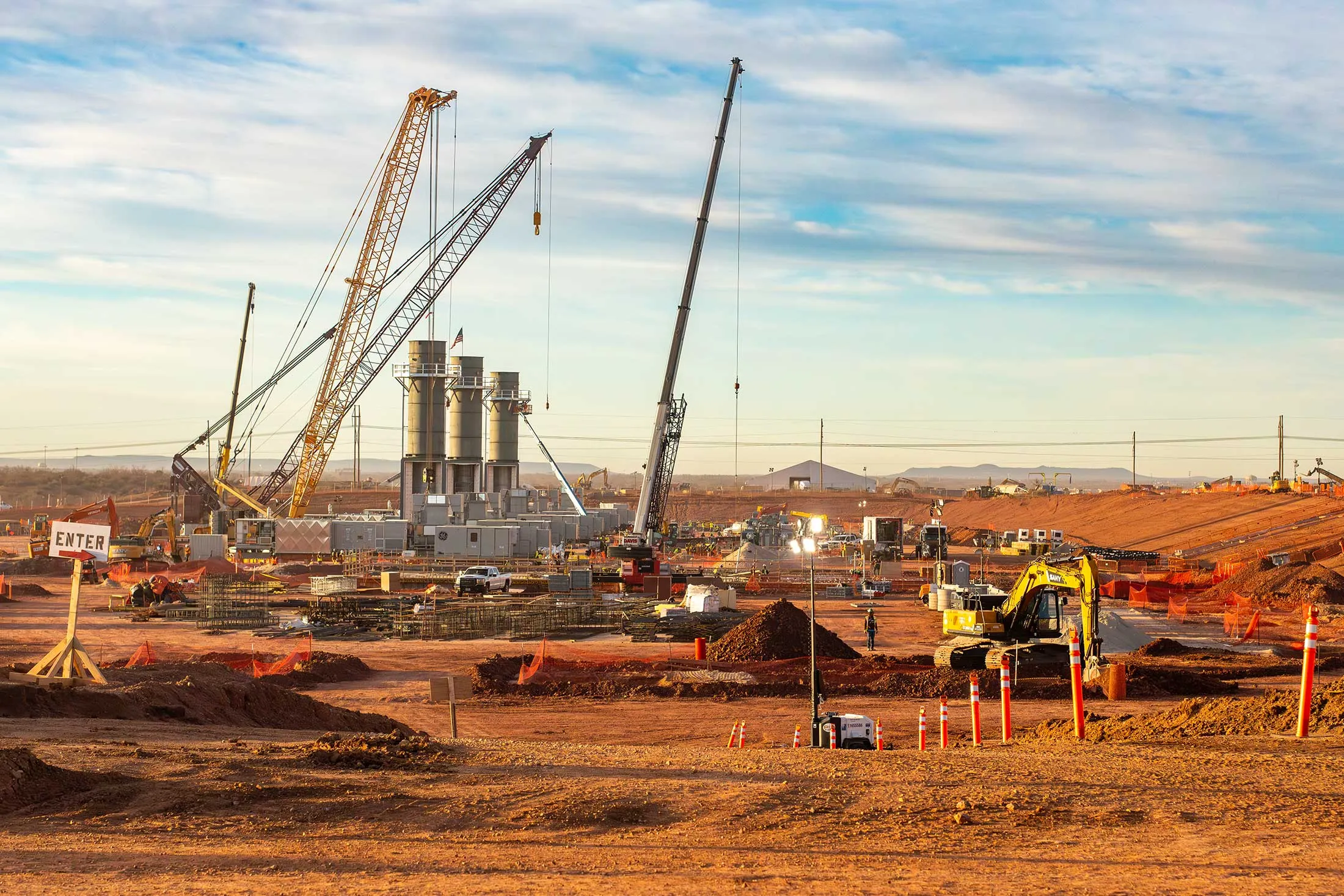 .
.
Photographer: Bobby Scheidemann for Bloomberg Businessweek
Trucks carrying concrete and electrical wiring plod over red clay, weaving in between cranes and excavators. Two symmetrical buildings stand in a massive plot of land where thousands of people in brightly colored vests work day and night to construct six more near-identical structures that will make up the first site for the Stargate Project.
Stargate is a collaboration of OpenAI, Oracle and SoftBank, with promotional support from President Donald Trump, to build data centers and other infrastructure for artificial intelligence throughout the US. The companies have pledged to spend as much as $500 billion, a number so large that it’s hard to believe it’ll actually happen. But at least for this one, in Abilene, Texas, 180 miles west of Dallas, Chase Lochmiller says they’re good for the money.
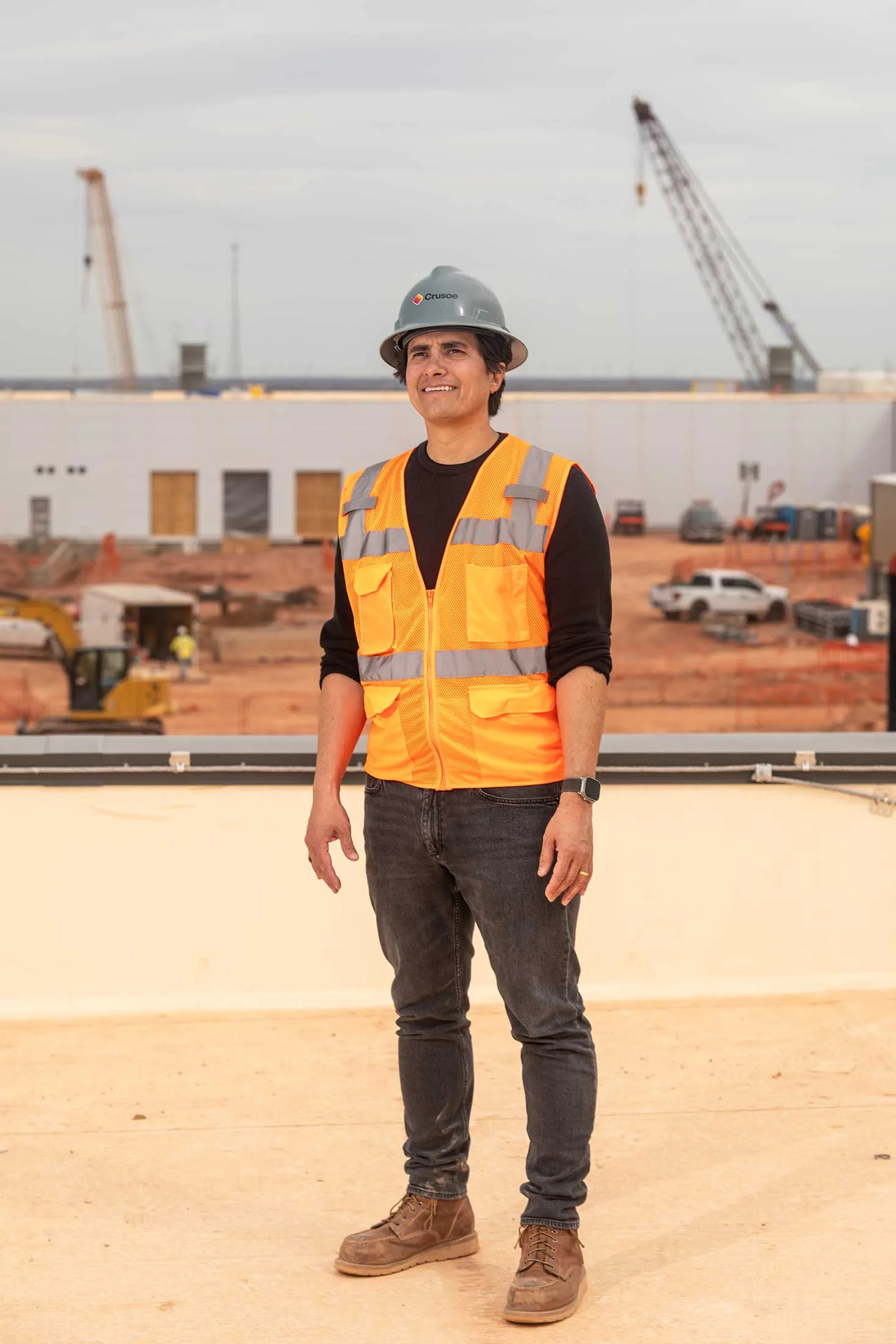
Lochmiller on the roof of the data center in Abilene.Photographer: Bobby Scheidemann for Bloomberg Businessweek
Lochmiller is the co-founder and chief executive officer of Crusoe, a startup that helps develop AI data centers. Crusoe’s costs to build the one in Abilene are expected to reach about $12 billion, Lochmiller says. And that’s not counting the billions of dollars’ worth of Nvidia Corp. chips that will be installed in the finished facility. “I’ve never built anything of this scale,” Lochmiller says. “I’ve had to learn a lot on the job.”
The three main companies behind Stargate could say the same thing. OpenAI knows AI but has relied on Microsoft Corp. for data centers. Oracle Corp. knows databases but only holds 3% of the cloud market. SoftBank Group Corp. once raised a $100 billion fund, but that didn’t go so well, and the Japanese investment firm has some things to prove. The only companies that have built cloud infrastructure on this scale—Amazon.com, Google and Microsoft—aren’t involved as investors, and none of them did it at the pace the Stargate collective is targeting. Initial plans call for it to quickly build at least 10 sites in the US.
In interviews with Bloomberg Businessweek, the CEOs of OpenAI and SoftBank acknowledge that they’ve promised a lot and that to some extent they’re figuring things out as they go. They dismiss critics—the loudest being Elon Musk—who say the full scope will never be realized because they don’t have the money. “We don’t need $500 billion in one day,” says SoftBank CEO Masayoshi Son. “We’ll go step by step.”
OpenAI CEO Sam Altman knew they’d need construction crews and lots of computers. But data centers also have extensive electricity and water needs to keep the machines running at a safe temperature—often requiring infrastructure upgrades that can take years. For Abilene, which will have a mighty capacity of 1.2 gigawatts, the team built its own gas power plant to get the place running more quickly. “One of the things that really surprised me as we were starting to dig into this,” Altman says, “was just how many things feed into the mainline.”
The mainline is still being assembled. At the Abilene site in March, some rooms are in the process of being wired and are off-limits due to the risk of electrocution. In the future, tubes will pump cooling liquid around servers, which will be loaded with Nvidia graphics processing units (GPUs), the physical brains of AI. For now, those tubes dangle from the ceiling beside half-lit hallways.
“We’re trying to deliver on the fastest schedule that a 100-megawatt-or-greater data center has ever been built,” Lochmiller says from the front seat of a buggy on a ride through the construction site. “In this moment, speed matters a lot.”
The big reveal for Stargate was at the White House on Day 2 of Trump’s second term. Altman, Son and Oracle Chairman Larry Ellison stood beside the president in the Roosevelt Room, lavishing praise and crediting him with helping make the project possible. The whole production came together in a matter of days, according to a person familiar with the event’s planning who asked not to be identified because the details are private.
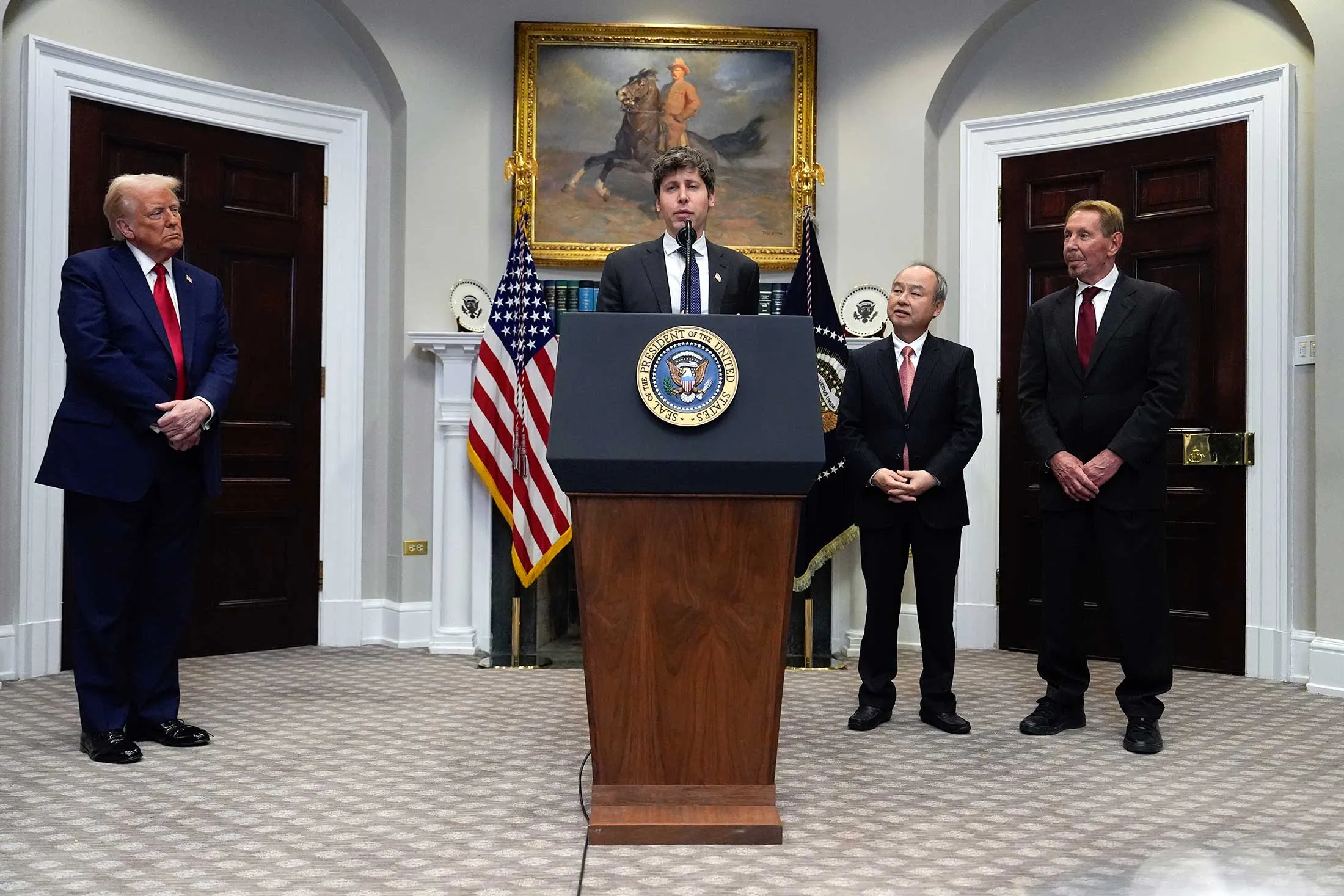
Altman speaking in the White House’s Roosevelt Room with Trump, Son and Ellison.Photographer: Julia Demaree Nikhinson/AP Photo
Stargate’s real origin, according to Peter Hoeschele, vice president of infrastructure strategy and operations at OpenAI, goes back to a research paper published at the beginning of the decade. Written by a group at OpenAI that included Dario Amodei, who’d go on to start one of the company’s main rivals, Anthropic PBC, the paper described so-called scaling laws, which assume that more capable AI requires ever-more data and computing resources.
OpenAI already had a contract designating Microsoft, its primary financial backer, as its exclusive cloud provider, but Altman decided he’d eventually need other options. Oracle was looking for partners for the future complex in Abilene and was talking with Musk before Altman came in, says a person familiar with the discussions who requested anonymity. (Musk instead chose Memphis for a data center to support his startup xAI.)
Altman picked the name Stargate because one of OpenAI’s early data center designs resembled the ring-shaped portal that could open a wormhole in the 1990s science-fiction movie of the same name. After half a year of Altman selling the idea to prospective backers, Stargate really came into focus in mid-2024, and he says he found himself in “a lot of Zoom meetings” with Ellison and Son.
“The hardest part was figuring out what the shape of the deal should be,” according to Altman. “Should it be part of OpenAI? Should it be a separate entity? Should we just try to get one company to build all of it for us? That just took a lot of exploration.”
They still haven’t figured it all out. OpenAI, Oracle and SoftBank all hold shares in a standalone company called Stargate LLC. They haven’t yet named a board or CEO. OpenAI is responsible for operations of the business and will be its main customer. SoftBank handles the financial side, including raising additional funds. For Abilene, Oracle will lease the data center and fill it with servers. (Crusoe declined to comment on its customers. OpenAI says it could work with other cloud partners on future sites.)
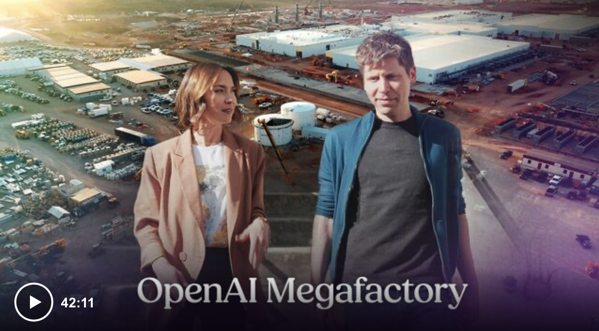
OpenAI and SoftBank will each put in $19 billion to start; Oracle and another equity partner, Abu Dhabi-based investment firm MGX, are on the hook for $7 billion apiece, according to a person familiar with the agreement. The companies all declined to comment on the funding.
Each project will be financed individually with a mix of equity and debt, according to Son. Data center firm Primary Digital Infrastructure Inc. is helping orchestrate the financing for Abilene, with loans from JPMorgan Chase & Co. and other firms, and energy company Lancium is developing the electrical infrastructure on-site.
For future sites, SoftBank has held talks with dozens of lenders and alternative asset managers, although it’s yet to secure a deal and some of those conversations have slowed due to global market volatility, Bloomberg News reported on May 12. (SoftBank later disputed that its progress had been curbed.) “That’s a structured financing that SoftBank has done many times in the past,” Son says. “So we are very confident.”
Not everyone is so optimistic about SoftBank’s ability to execute. The last time Son did anything close to this scale was the Vision Fund, which depended on a $45 billion contribution from Saudi Arabia’s largest sovereign wealth fund. SoftBank’s fund racked up losses, most disastrously on the office real estate startup WeWork.
“Sometimes I get crazily overexcited, and I make a mistake, like WeWork,” Son says. “But when you have the conviction and the passion, you actually learn more from those mistakes and the scars, and that will make you stronger. I made so many more mistakes that I think I’m a little stronger than in the past.”
Complicating matters are Trump’s tariffs. Cost calculations swing every time the president changes his mind, but the trend line is expected to go up on aluminum, steel and other construction supplies, not to mention Nvidia GPUs, which are mainly made by Taiwan Semiconductor Manufacturing Co. Son says he expects no significant impact from the trade policies, and in a separate interview, Altman says the president is helping in other ways. “Trump’s focus on permitting and the energy requirements for this and the ability to just get that done is great,” Altman says.
A big question is whether OpenAI will need such massive volumes of computing resources in the future. The emergence of vastly more efficient AI models from DeepSeek and other companies that rely on reasoning capabilities have challenged the notion of the scaling laws that inspired Stargate. Alibaba Chairman Joe Tsai has raised the possibility that we’re in the middle of a data center construction bubble, and Amazon and Microsoft have pulled back on some data center plans.
Altman is undeterred, still seeing computing capacity as a precious resource. “We need more compute and more capital,” he says. “We want to have access to a lot of the machinery to make AI and run AI.”
The Abilene skyline is made up largely of buildings constructed in the 1920s during the Texas oil boom. Among the city’s major employers is a nearby Air Force base and a cheese production plant that opened in 2022. Meanwhile, activity at the Stargate site—spanning 900 acres, larger than New York City’s Central Park—moves at the pace of a boomtown.
The team behind the Abilene data center, conceived under the code name Project Ludicrous, first put shovels in the ground in June 2024. Crusoe decided to fly in workers from all over the country, because the city of 129,000 didn’t have a labor force large enough to support it, Lochmiller says. It’s projected to take slightly more than two years for the entire project to go from start to finish, although parts of the data center are slated to go online sooner.
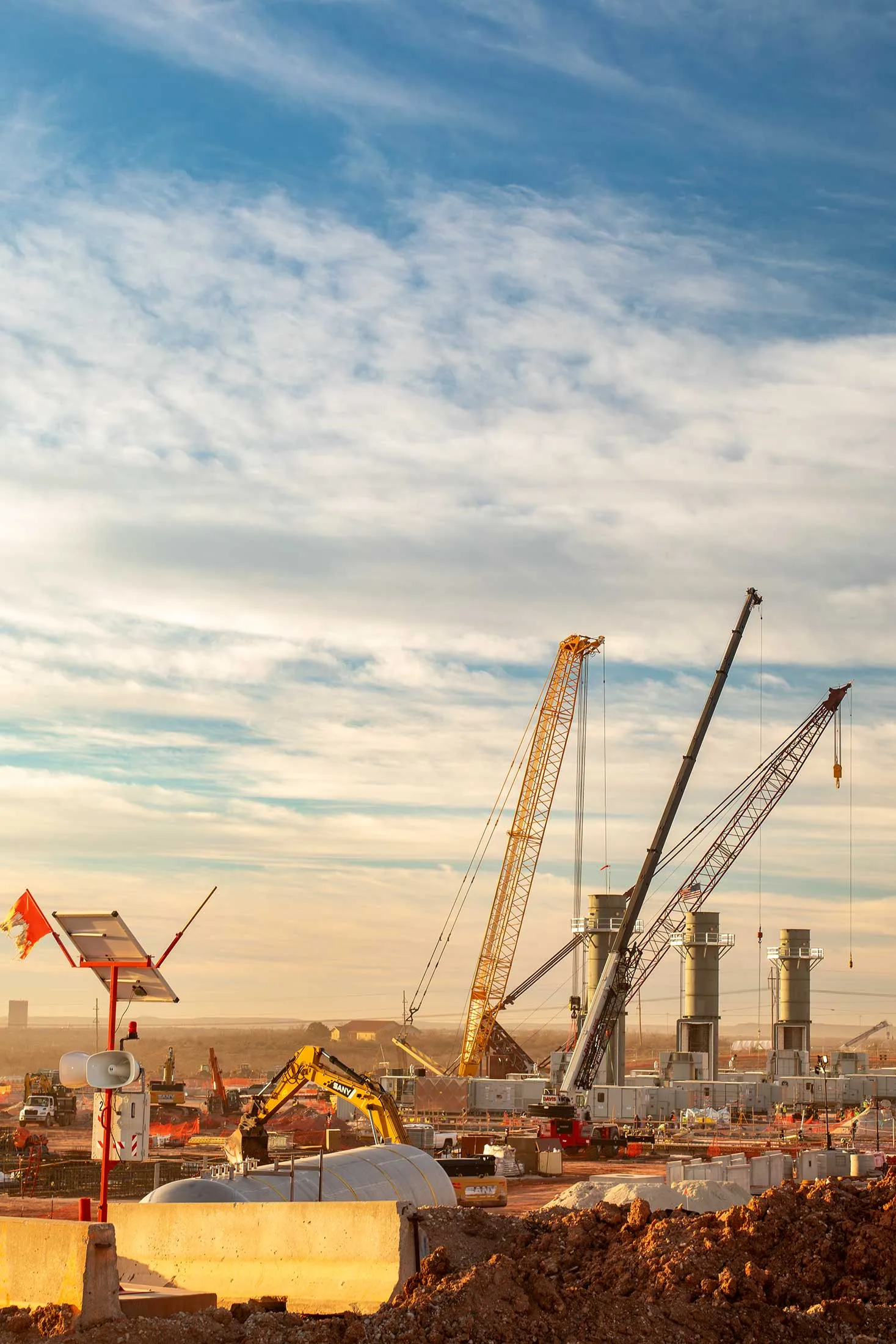
The Stargate team is installing gas turbines made by GE Vernova for an on-site natural gas plant.Photographer: Bobby Scheidemann for Bloomberg Businessweek
Towns like Abilene are usually on the losing end of technological change, which tends to create the most jobs in the largest cities. And data centers traditionally don’t employ that many people. Crusoe has promised officials the Abilene site will deliver 357 full-time jobs once construction has finished—a little more than the average Walmart Supercenter.

The Abilene government is hopeful that it’s the start of something bigger. The city and county agreed to extend significant tax breaks to get the deal done, and local officials saw an influx of requests in the days after Stargate was announced from housing developers, energy infrastructure vendors, would-be investors and other municipal governments desperate to bring jobs to their towns. “It will impact the rest of the economy—our restaurants, our homebuilders—with that many new people coming in and taking these jobs,” Mayor Weldon Hurt says.
The city was able to accommodate Stargate’s water needs, which are small compared to a typical server farm due to a novel cooling method that recycles most of the liquid. The trade-off is that the data center will require a great deal of electricity—enough to power hundreds of thousands of homes. Data centers of this scale are “unprecedented,” says Gordon Dolven, who leads research on the data center market for real estate company CBRE Group Inc.
This was cause for concern in Abilene, where the memory of the 2021 Texas blackouts, which led to the deaths of six people in the county, is still fresh in people’s minds. Much of the blame for those outages belongs to Texas’ deregulated energy grid. But the flexibility that comes with that lack of regulation was part of the allure for Stargate. Crusoe went out and bought gas turbines and oversaw the construction of a natural gas plant on-site, which will supplement what the data center can get from local utilities.
To Stargate’s critics, the idea that the project’s backers could maintain this pace and scale across the country is reason to think they’re living in a fantasy. Amodei, co-creator of the scaling laws, publicly questioned Stargate’s seriousness, calling it “chaotic.” Musk, breaking with Trump, called it “fake.” (Altman’s retort: “He says all sorts of crazy stuff.”)
Salesforce Inc. CEO Marc Benioff said in a post on X in April that Stargate signaled an end to the “honeymoon” between OpenAI and Microsoft. The project does reflect a shift in the relationship between the two companies. They revised their cloud contract in January to allow OpenAI to use other vendors, such as Oracle, as long as Microsoft has first right of refusal. Microsoft doesn’t intend to invest in Stargate but was listed by OpenAI as a “technology partner” in the project.
If things go as planned, Abilene could serve as a model for the next Stargate developments. The day after Altman first visited the Abilene site in early May, he testified before Congress, asking for help to fast-track data center permitting on future locations. “The first site was incredible. We need a lot more of that,” he said.
Crusoe is evaluating another potential spot in Amarillo, Texas, which it hopes could be part of Stargate, according to a person with knowledge of the deliberations who asked not to be named discussing a private process. OpenAI has said it’s also looking in several states including Oregon, Pennsylvania and Wisconsin, and Stargate might rent data centers already being built elsewhere. Meanwhile, OpenAI and Oracle are taking the spirit of Stargate international with an AI data center under development in Abu Dhabi, which will not be part of Stargate LLC but will count OpenAI as a customer, Bloomberg News reported.
If all that wasn’t enough, Stargate could even expand to include semiconductor production, according to Altman—perhaps as soon as next year. “I think of Stargate as the AI factory,” he says.
“If we didn’t have to be involved here,” Altman says, “maybe we wouldn’t, if we could just magically spin up all the compute we needed in the sky. But at this kind of scale, you can’t do that.”
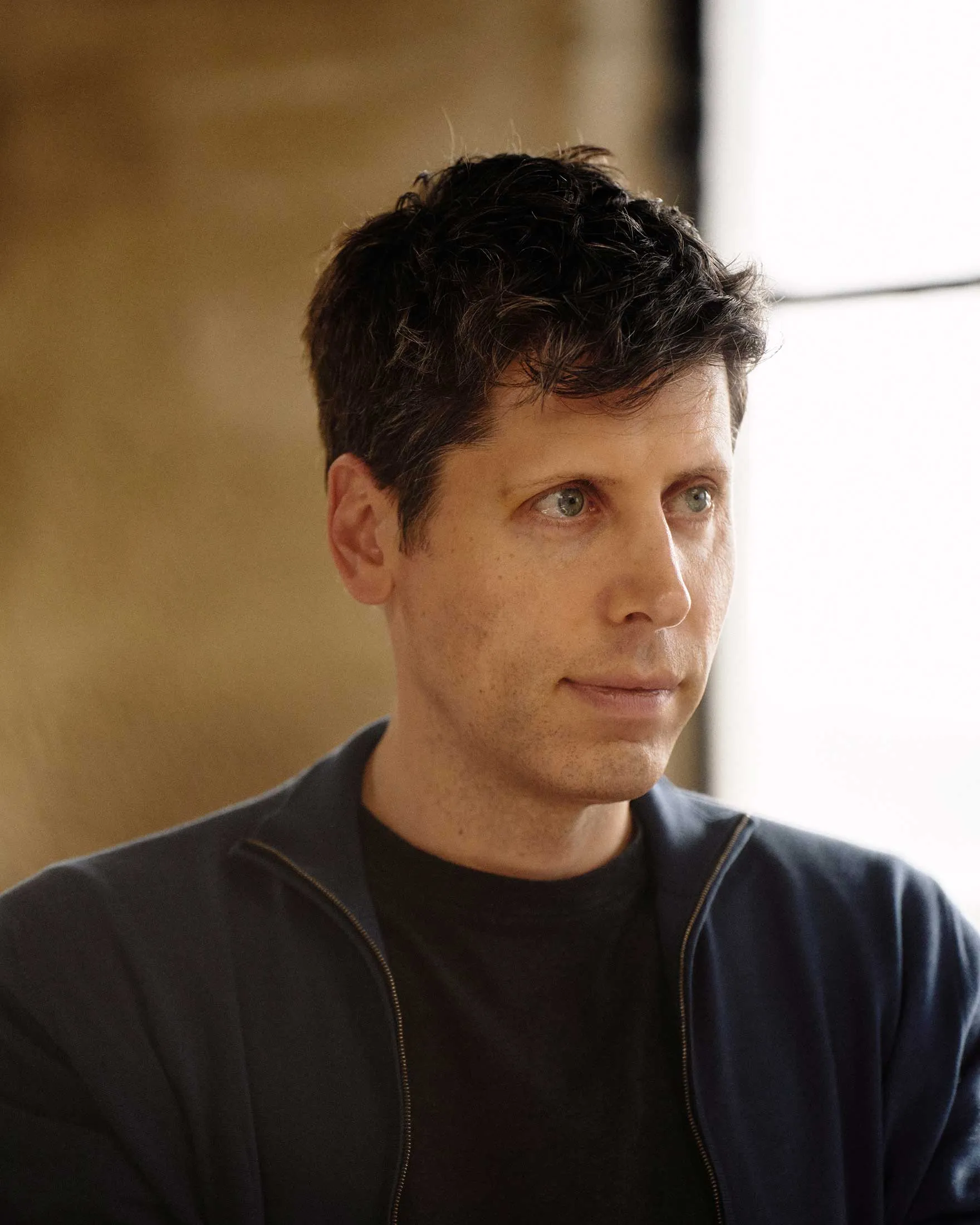
Altman at OpenAI’s headquarters in San Francisco.Photographer: Balazs Gardi for Bloomberg Businessweek

